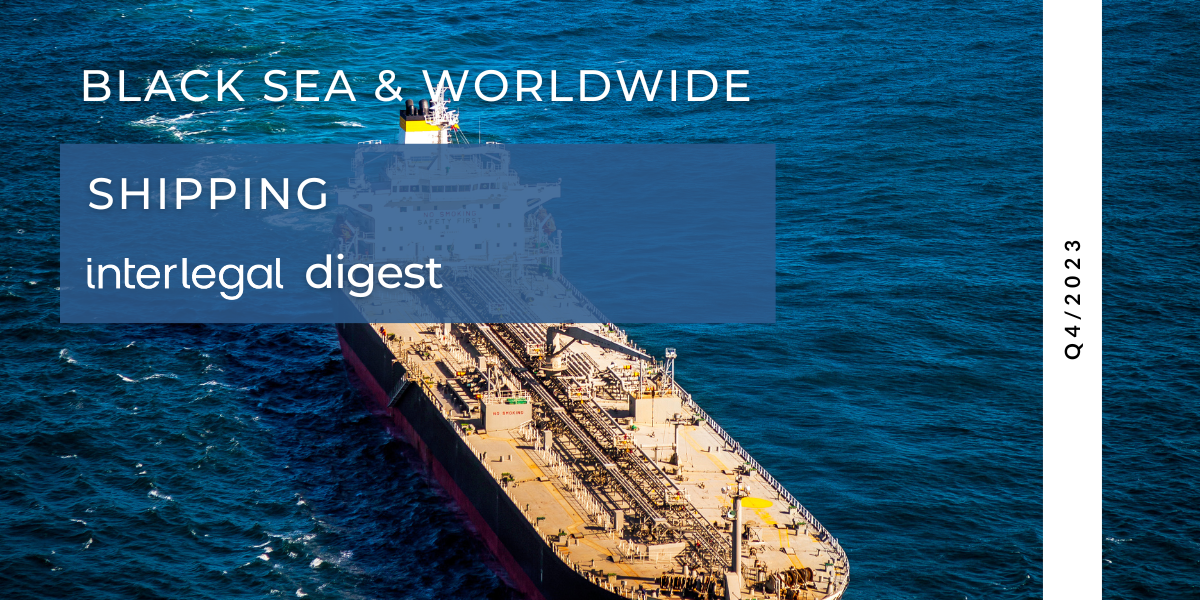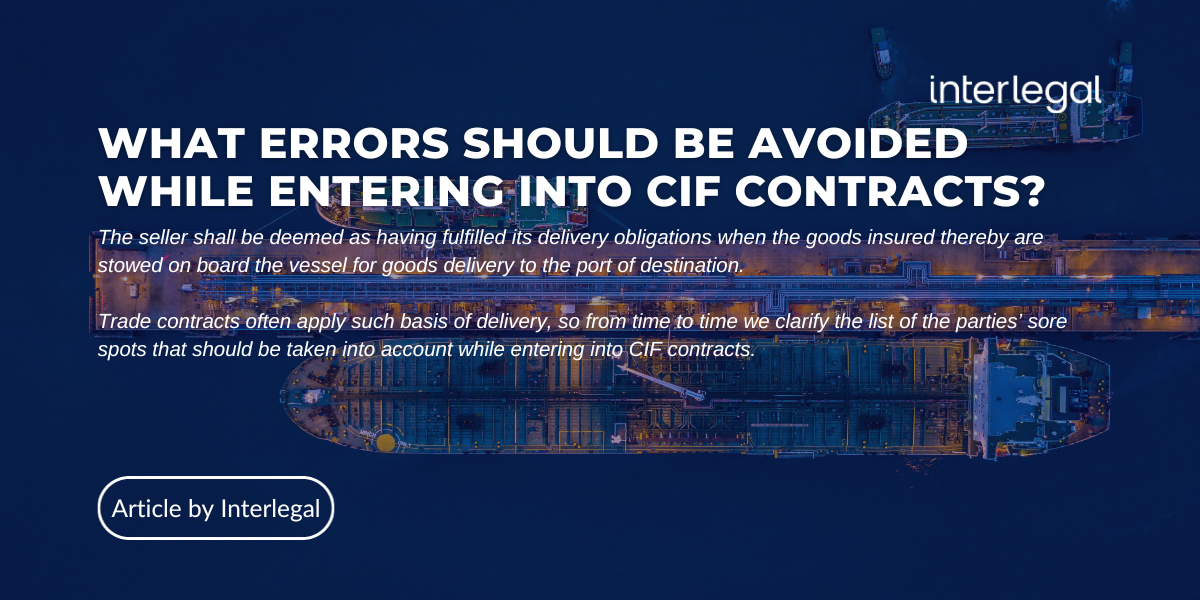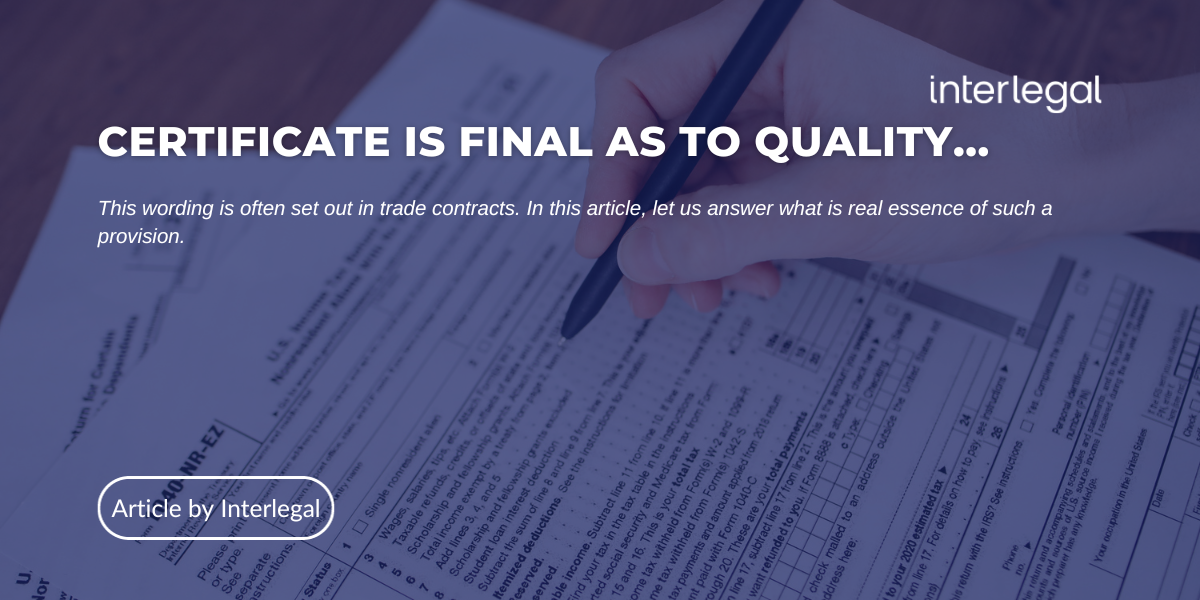Interlegal Quarterly Shipping Newsletter Q4, 2021
28 December, 2021
5

Demurrage an exclusive remedy: the Court of Appeal gives judgment in The Eternal Bliss – Simon Rainey QC & Tom Bird
In the recent case of The “Eternal Bliss” the High Court decision changed the landscape for owners and voyage charterers by establishing that damages in excess of demurrage can be claimed by owners, even where the only breach was the failure to load and discharge within the laytime. Previously, demurrage had been thought to be a complete code for damages caused by that breach. Then the Court took opposite approach allowing to claim costs on the top of demurrage for the Charterers’ failure to complete cargo operations in time. However, the Court of Appeal has now handed down a judgment that has overturned that decision, less than a month after the hearing.
The dispute arose from a voyage charter for the carriage of soybeans from Brazil to China.
At the discharge port, the vessel was kept at anchorage for 31 days due to port congestion and a lack of storage space ashore for the cargo. As a result of the delay, the cargo suffered significant moulding and caking and the receivers brought a claim against the Owners which the Owners subsequently settled for US$1.1 million. The Owners then commenced arbitration proceedings against the Charterers seeking damages or an indemnity in respect of that cost. The sole breach of contract relied on was the charterers’ failure to discharge within the laytime.
The Charterers invariably argued that demurrage is a complete code of damages for delay, and that in order to claim damages over and above the demurrage rate, it is necessary to show both a breach of a separate obligation (distinct from the obligation to load and discharge within the agreed laytime) and a different type of loss. This is the leading view which has been applied for a long time.
However, the Owners invited the Court to determine this point of law. At first instance, Andrew Baker J held that the cargo claim liabilities were a different type of loss to the detention of the vessel and that the shipowner could recover damages without proving a separate breach of contract. The 1991 decision in The Bonde (in which Potter J had reached the opposite conclusion) was, he said, wrongly decided. Therefore, the High Court decision in The “Eternal Bliss” came down on the owners’ side.
However, just over a year after the judgment, the Court of Appeal heard the charterers’ appeal of the first-instance decision.
The Court of Appeal held that demurrage liquidates all damages arising from a charterer’s failure to complete cargo operations within the laytime, in breach of charter, because:
– it would be “unusual and surprising” to liquidate only some of the damages arising from a particular breach;
– demurrage is intended to compensate owners for the loss of prospective freight, but the loss of freight is not the only factor;
– The “Bonde”, overturned by the first-instance decision in this case, had stood almost unchallenged for over 30 years, and hence could be seen as settled law;
– allowing owners to claim damages in addition to demurrage would disturb “the risk inherent in the parties’ contract”, which was already balanced between commonly insured losses on the one hand and demurrage on the other hand.
Since the first-instance decision in The “Eternal Bliss”, there has been a sharp increase in claims from owners for sums in addition to demurrage. It was related to attempts to pass on liability for cargo claims, which are usually brought against owners as carriers under the bill of lading contract in the first instance, and which are often worth millions of dollars. These claims previously struggled to find a separate breach and, following the rejection of The Bonde, this obstacle had been cleared.
Now, however, the floodgates have firmly closed on those claims (at least, until the Supreme Court has had an opportunity to hand down a decision). It follows that, as per the Court of Appeal, the state of the law on demurrage is now that “if a shipowner seeks to recover damages in addition to demurrage arising from delay, it must prove a breach of a separate obligation”.
A time charter chain in a rising market – Nicola Cox, Head of Defence, West P&I
A case study in common time charter issues including: calculating the redelivery date and final hire due, withdrawal of the vessel from charter and the effect of withdrawal down the charter chain.
A recent case for one charterer in the middle of a time charter party chain highlights a number of “core” charter party issues, with some surprising results. Both the head and sub charters provided:
– Redelivery of the vessel was to be latest 16 May plus any offhire periods, as long as charterers (in each case) gave notice at least 30 days before the charter party’s original redelivery date.
– On redelivery, charterers (in each case) had the right to deduct the value of redelivery bunkers (the bunker prices were agreed in the charters) “from the last sufficient hire payments”. The value of bunkers on delivery at the agreed charter party prices amounted to more than US$400,000 which was equivalent to more than two full hire instalments at the sub charter hire rate and just over three full hire instalments at the (lower) head charter hire rate.
– There was a right of withdrawal of the vessel from charter with a grace period of three clear banking days.
The dispute arose from below events:
On 28 February, sub charterers paid the 13th hire instalment based on a redelivery date of 20 April and making a deduction from hire in respect of part of the estimated bunkers on redelivery.
Between 3-5 March the vessel’s schedule slipped and updated voyage orders were sought down the charter chain. Sub charterers subsequently stated that they intended the vessel to perform a voyage from a Black Sea port either to the Persian Gulf or Singapore/Japan range (ie a front haul voyage) and that they intended to exercise their right to extend the charter party by adding off hire periods. Owners, in response, did not consider that either voyage could be performed within the charter party period remaining, and refused to allow a front haul last voyage. Charterers passed this message down to sub charterers the same day.
Whilst owners and sub charterers continued to dispute the issue, on 13 March sub charterers sub-fixed the vessel “on subjects” to perform a final voyage to the Persian Gulf. The vessel was fixed “firm” on 15 March.
Owners withdraw the vessel from charter:
By the March when hire instalments were due under both charters but no payment was made by charterers nor sub charterers, each maintaining that they were entitled to deduct the value of the redelivery bunkers from hire due up to the anticipated 20 April redelivery date.
Owners served an anti-technicality notice on Charterers on 16 March for a stated amount of unpaid hire and Charterers served an anti-technicality notice on sub charterers (stating a different amount of unpaid hire) on the same day. This was followed by a notice of withdrawal on Sunday 25 March sent by owners to Charterers and sub charterers which Charterers also forwarded to sub charterers on 25 March.
The vessel completed discharge on 29 March.
Questions arising:
Charterers’ last voyage orders and the expected redelivery date under both charter parties:
1. Assessing whether charterers’ last order was legitimate in that it would have enabled the vessel to be redelivered in time, the tribunal held that the appropriate test is whether the estimated redelivery date was one which “could reasonably be held by any intelligent charterer”.
2. The tribunal held that, because owners were refusing to allow the vessel to perform a PG voyage as sub charterers had requested, owners were not then entitled to argue that a realistic redelivery date had to be based on the PG voyage. This was the case even though sub charterers had, in fact, fixed the vessel for a PG voyage.
3. The charterers have a continuous obligation to assess whether their last voyage orders are realistic in terms of the estimated redelivery date for the vessel and that, where there is slippage in the vessel’s schedule, charterers should reassess and, if necessary, give different last voyage orders.
Anti-technicality notices and withdrawal:
Because the tribunal held that the 20 April redelivery date was given by sub charterers and Charterers in good faith and on reasonable grounds and that the amount of hire due was correctly calculated the tribunal held that there was no hire due but unpaid when owners served their anti-technicality notice on 20 March. Therefore, owners were themselves in repudiatory breach of the head charter and Charterers were in repudiatory breach of the sub charter by wrongly exercising the right to withdraw the vessel from charter for alleged non-payment of hire.
The middle charterer’s position in a charter chain:
Whilst Charterers forwarded the owners’ notice of withdrawal to sub charterers on the same day of receiving it, Charterers did not ask sub charterers to treat owners’ message as having come from Charterers. Accordingly, the tribunal found that the withdrawal of the vessel from the sub charter – had the withdrawal been valid – would only have taken place when Charterers served their own withdrawal notice on sub charterers.
The calculation of damages:
1. Where owners have withdrawn the vessel from charter wrongfully, the sub charterers could only claim the “normal”, market loss measure of damages, namely the difference between the charter and (higher) market rate.
2. The charterers can claim these market loss damages for the period from Charterers’ purported withdrawal of the vessel from charter to the maximum charter party period permitted to sub charterers, including added offhire periods.
Unseaworthiness in the Supreme Court: The CMA CGM Libra – John Russell QC and Benjamin Coffer
The Supreme Court handed down judgment in The CMA CGM Libra [2021] UKSC 51, its much-awaited analysis of seaworthiness and the due diligence obligation under the Hague and Hague-Visby Rules. The Court dismissed the appeal, upholding the decisions of Mr Justice Teare and the Court of Appeal.
The appeal arose out of the grounding of the container ship CMA CGM LIBRA while leaving the port of Xiamen, China in May 2011. The owners claimed general average contributions from the cargo interests. At first instance, Teare J held that the passage plan was defective because it failed to record a warning that depths shown on the chart outside the fairway were unreliable and waters were shallower than recorded on the chart. On that basis, Teare J held that the vessel was unseaworthy at the commencement of the voyage: the defects in the vessel’s passage plan and the relevant working chart rendered the vessel unseaworthy. The defects were causative, because if the warning had been on the chart, the Master would not have left the fairway. A strong Court of Appeal comprising three experienced shipping judges (Haddon-Cave, Flaux and Males LLJ) upheld his judgment in robust terms.
The owners appealed to the Supreme Court. The owners’ primary argument was that passage planning could not render a vessel unseaworthy because it involved no more than the recording of a navigational decision. The owners argued that a ship could only be unseaworthy if there was a defect affecting an “attribute” of the ship. Although it was incumbent on the owner to have on board everything necessary for the crew to carry out proper passage planning, such as a competent crew, up to date charts and proper systems and instructions, the crew’s use of that equipment was a matter of navigation or seamanship.
The owners also argued that even if the ship was unseaworthy, there was no relevant failure to exercise due diligence. Relying on the references in cases such as The Happy Ranger [2006] 1 Lloyd’s Rep 649 to the carrier’s “orbit” of responsibility, the owners argued that navigation was outside their “orbit” because it was a matter solely for the Master and crew.
Giving the leading judgment, Lord Hamblen confirmed that the exceptions in Article IV.2 cannot be relied upon in relation to a causative breach of Article III.1. If a vessel is unseaworthy it therefore makes no difference whether negligent navigation or management is the cause of the unseaworthiness or is itself the unseaworthiness.
The Court also accepted that the presence of dangerous cargo can cause or constitute unseaworthiness, so that the carrier may be liable where it cannot show that it exercised due diligence
Given the “essential importance” of passage planning for safe navigation, Lord Hamblen pointed out that a vessel is likely to be unseaworthy applying the prudent owner test if she begins her voyage without a passage plan or if she does so with a defective passage plan which endangers the safety of the vessel.
The owners’ arguments on due diligence also failed. The Court reaffirmed the non-delegable nature of the carrier’s obligation under Article III.1: the obligation on the carrier to exercise due diligence to make the vessel seaworthy requires that due diligence be exercised in the work of making the vessel seaworthy, regardless of who is engaged to carry out that task. It makes no difference that the task may have a navigational element to it.
The carrier is therefore liable for a failure to exercise due diligence by the master and deck officers of his vessel in the preparation of a passage plan for the vessel’s voyage. The fact that navigation is the responsibility of the master and involves the exercise by the master and deck officers of their specialist skill and judgment makes no difference. The carrier’s obligation requires the carrier to ensure that a proper passage plan is prepared; not merely to provide a proper system to enable the crew to carry out the required planning exercise.
Read our full digest here.

























































